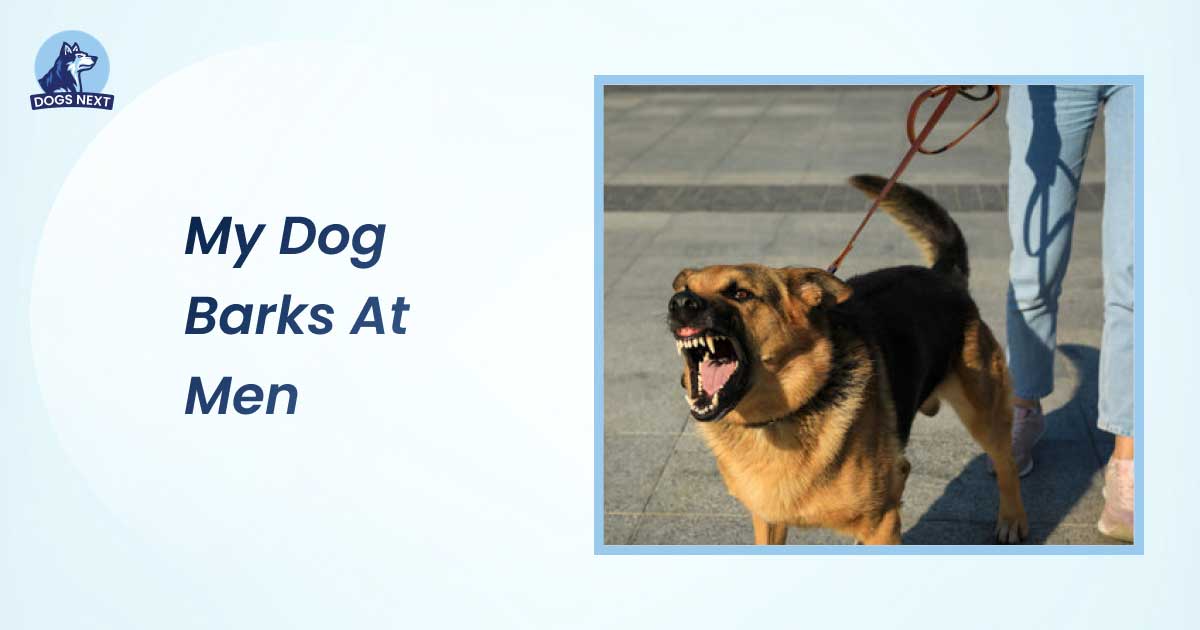Your dog barks at men due to fear or past negative experiences. Proper training and socialization can help manage this behavior.
Dogs often bark at men because of fear, insecurity, or previous negative encounters. This behavior can be challenging for pet owners, causing stress for both the dog and the family. Addressing the root cause is crucial for effective management. Training and socialization are key strategies to help your dog feel more comfortable around men.
Professional guidance from a dog trainer or behaviorist can be beneficial. Understanding your dog’s triggers and working on gradual desensitization can lead to significant improvements. Patience and consistency are essential throughout this process. With the right approach, your dog can learn to feel more at ease and reduce its barking at men.
Dogs Barking Behavior
Dogs barking behavior can be puzzling for many pet owners. One common issue is barking at men. This behavior often leaves owners frustrated and confused. Understanding why dogs bark and how to address this issue is crucial. Below, we explore the reasons behind this behavior and the difference between fear and aggression.
Why Do Dogs Bark At Men Specifically?
Several factors cause dogs to bark at men. Here are some common reasons:
- Past Experiences: Dogs may have had negative encounters with men. This can lead to fear and barking.
- Appearance and Smell: Men often have different physical features and scents compared to women. Dogs may react to these differences.
- Voice Tone: Men typically have deeper voices. Some dogs find this intimidating.
- Body Language: Men may have more assertive body language. Dogs can perceive this as a threat.
Here is a table summarizing these reasons:
| Reason | Description |
|---|---|
| Past Experiences | Negative encounters with men can cause fear. |
| Appearance and Smell | Differences in physical features and scents. |
| Voice Tone | Deeper voices can be intimidating. |
| Body Language | More assertive body language perceived as a threat. |
Fear Vs. Aggression
Understanding whether your dog is barking out of fear or aggression is important. Fear and aggression may look similar but have different root causes.
Fear: Fear-based barking is a common issue. Dogs may feel threatened and bark to protect themselves. Signs of fear include:
- Tucked tail
- Ears back
- Shaking
- Attempting to hide
Aggression: Aggressive barking is different. It often stems from a desire to protect territory or assert dominance. Signs of aggression include:
- Raised hackles
- Showing teeth
- Stiff body posture
- Growling
Here’s a table to help differentiate between fear and aggression:
| Behavior | Fear | Aggression |
|---|---|---|
| Tail Position | Tucked | Raised |
| Ear Position | Back | Forward |
| Body Posture | Shaking | Stiff |
| Vocalizations | Barking, whimpering | Growling, barking |
Recognizing these signs helps address the root cause of your dog’s barking. This leads to more effective solutions and a happier, quieter pet.
Common Triggers
Dogs often bark at men due to a variety of triggers. Understanding these common triggers can help you address and manage your dog’s behavior effectively. By recognizing the specific causes, you can take steps to reduce your dog’s anxiety and create a more peaceful environment.
Body Language Of Men
Dogs are highly sensitive to body language. Men often have different postures and movements compared to women, which can be interpreted as threatening by dogs. For instance, a man’s larger stature and more assertive walk can intimidate a dog. Here are some common body language triggers:
- Standing Tall: Men often stand taller and more upright, which can appear dominant and threatening to a dog.
- Direct Eye Contact: Direct eye contact can be seen as a challenge by dogs.
- Quick Movements: Sudden or quick movements may startle a dog and cause them to bark.
- Hand Gestures: Waving hands or making large gestures can confuse or scare a dog.
Understanding these body language cues can help in training your dog to feel more comfortable around men. Consistent exposure and positive reinforcement when men display non-threatening body language can gradually reduce your dog’s barking.
| Trigger | Dog’s Perception | Solution |
|---|---|---|
| Standing Tall | Threatening | Encourage men to kneel or sit |
| Direct Eye Contact | Challenging | Advise men to avoid direct staring |
| Quick Movements | Startling | Promote slow, calm movements |
| Hand Gestures | Confusing | Minimize large hand movements |
Men’s Voices And Movements
Men often have deeper voices and different vocal tones compared to women. These differences can trigger barking in dogs. A deep, booming voice can be perceived as a threat. The louder volume and more abrupt speech patterns can also startle a dog. Consider the following:
- Deep Voices: The bass in a man’s voice can be alarming to a dog.
- Loud Speaking: Speaking loudly or shouting can scare a dog.
- Fast Speech: Rapid talking can confuse and agitate a dog.
Movements also play a crucial role. Men often have more pronounced and vigorous movements. This can include things like:
- Heavy Footsteps: The sound of heavy footsteps can make a dog anxious.
- Large Gestures: Wide arm movements can seem unpredictable to a dog.
To help your dog feel more at ease, encourage men to use calm, soothing tones and gentle, deliberate movements. Gradually exposing your dog to these controlled interactions can help desensitize them and reduce barking incidents.
How To Calm Your Dog
Is your dog barking at men? This behavior can be stressful for both you and your dog. Understanding how to calm your dog is crucial. By implementing specific techniques, you can help your dog feel more comfortable around men and reduce their barking.
Desensitization And Counterconditioning
Desensitization and counterconditioning are effective ways to help your dog stop barking at men. These methods involve gradually exposing your dog to men in a controlled manner.
Start by following these steps:
- Introduce your dog to men from a distance where your dog feels safe.
- Gradually decrease the distance over time.
- Use treats to create a positive association with the presence of men.
Here’s a simple table to guide you through the process:
| Step | Action |
|---|---|
| 1 | Observe your dog’s comfort distance. |
| 2 | Introduce a man at this distance. |
| 3 | Reward your dog with treats. |
| 4 | Gradually reduce the distance. |
| 5 | Continue rewarding your dog. |
Consistency is key. Repeat these steps daily. Your dog will start to feel less anxious around men.
Socialization Techniques
Socialization is important for reducing your dog’s barking at men. Expose your dog to different environments and people.
Follow these techniques:
- Invite friends over, including men, for short visits.
- Take your dog to parks where men are present.
- Enroll your dog in a training class with male instructors.
During these activities, remember to:
- Keep interactions positive and calm.
- Reward your dog for calm behavior.
- Avoid forcing interactions.
Here’s a simple checklist to help:
| Task | Status |
|---|---|
| Invite male friends over | Pending/Completed |
| Visit parks with your dog | Pending/Completed |
| Join a training class | Pending/Completed |
By using these socialization techniques, your dog will start to feel more comfortable around men. This will help reduce their barking behavior.
Professional Help From A Trainer
Does your dog bark at men? This behavior can be troubling. You might feel frustrated or worried. Seeking professional help from a trainer could be the answer. A trainer understands dog behavior. They can help your furry friend feel more comfortable around men.
Understanding Your Dog’s Behavior
Dogs bark for many reasons. Sometimes, it’s fear or anxiety. Other times, it’s a past bad experience. A professional trainer will identify the cause. They will observe your dog closely. This helps them create a plan tailored to your dog’s needs.
Customized Training Plans
A trainer will design a customized training plan for your dog. This plan will address the specific issues your dog has with men. It may include:
- Desensitization techniques
- Positive reinforcement
- Behavioral modification exercises
This personalized approach ensures your dog gets the best care possible.
Desensitization Techniques
Desensitization helps your dog become less sensitive to men. The trainer will expose your dog to men in a controlled way. Over time, your dog will feel less anxious. This helps reduce barking.
Positive Reinforcement
Positive reinforcement is another key technique. Trainers reward your dog for calm behavior around men. This might include treats, praise, or playtime. Positive reinforcement encourages good behavior.
Behavioral Modification Exercises
Trainers use behavioral modification exercises to change your dog’s reactions. These exercises help your dog develop new, positive responses. They also teach your dog how to stay calm and relaxed.
Progress Tracking
A professional trainer tracks your dog’s progress. They adjust the training plan as needed. This ensures continuous improvement. Your dog will become more confident and less reactive to men.
Benefits Of Professional Help
Getting help from a professional trainer has many benefits:
| Benefit | Description |
|---|---|
| Expertise | Trainers have the knowledge to address complex behaviors. |
| Customized Plans | Plans tailored to your dog’s unique needs. |
| Faster Results | Professional guidance leads to quicker progress. |
| Reduced Stress | Less stress for both you and your dog. |
Working with a trainer can transform your dog’s behavior. Your home will be a happier, quieter place.
Frequently Asked Questions
Why Does My Dog Bark At Men?
Dogs may bark at men due to fear, past trauma, or lack of socialization. It’s essential to identify triggers and work on desensitization.
How Can I Stop My Dog Barking At Men?
Training and socialization can help. Gradually expose your dog to men in a controlled environment. Positive reinforcement works well.
Is Barking At Men A Common Problem?
Yes, many dogs bark at men due to fear or lack of socialization. Each dog is unique and may require different approaches.
Can Professional Training Help With Barking?
Yes, a professional trainer can provide specific techniques and guidance to address your dog’s barking behavior effectively.
Conclusion
Understanding why your dog barks at men can improve your relationship. Training and patience are key. Consider professional help if needed. Every dog is unique; find what works best for yours. By addressing the issue, you’ll foster a happier and more peaceful environment for both you and your furry friend.

I’m David, an expert contributor and writer, with two furry friends of my own, I know the challenges of raising and caring for dogs. From training to nutrition and health, my goal is to provide valuable insights and advice to help create strong bonds and happy, healthy lives. Find me in Twitter.



